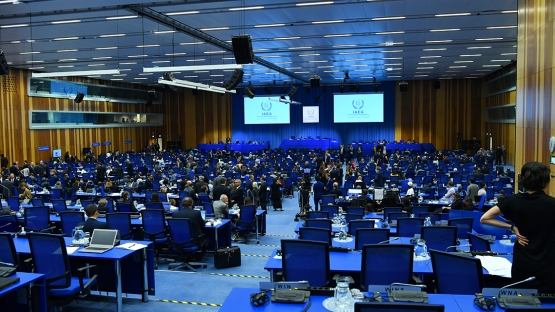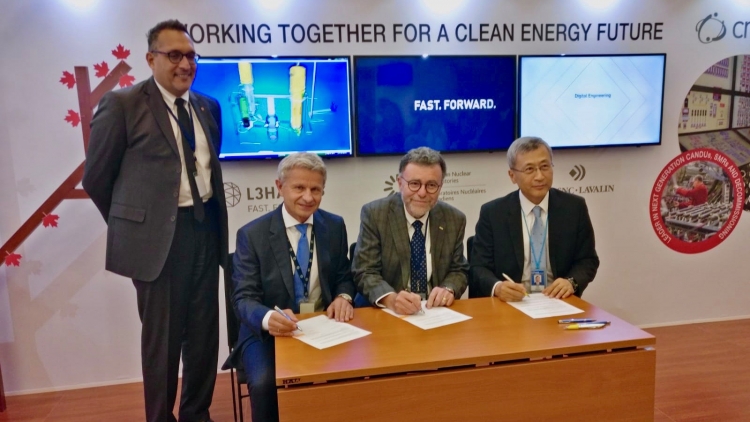At the start of the plenary session on the first day of the IAEA’s 63rd General Conference, Alicia Buenrostro Massieu of Mexico was elected by acclamation as President of the Conference.
IAEA Acting Director General Cornel Feruta in his opening statement highlighted the IAEA’s unique contribution to international peace, security and prosperity. He emphasised the verification activities of the IAEA to ensure that nuclear material stays in peaceful uses and thorough its work on the peaceful uses of nuclear technology to help improve the well-being and prosperity of people around the world.
A message from the Secretary-General of the United Nations was delivered at the plenary session and can be accessed here.
During the plenary session 34 delegations took part in the debate. Their full statements are available here.
The following side events took place on Monday:
The event Showcasing the ReNuAL Project and Highlighting its Accomplishments highlighted the progress achieved so far under this project. It was announced that the new Flexible Modular Laboratory will be named the “The Yukiya Amano Laboratories,” as a tribute to the late Director General Amano, who passed away last July. Iran and Nigeria were added to a symbolic donor wall of the IAEA Nuclear Applications Laboratories, marking their recent contributions to the renovation of the labs.
The annual Treaty Event promotes universal adherence to the multilateral treaties for which the IAEA Director General is depositary. During this event, representatives of four countries deposited legal instruments expressing consent to be bound by various multilateral treaties.
At the International Nuclear Safety Group Forum on the Safety–Security (INSAG) Interface event experts discussed the progress related to the interface between nuclear safety and security, and the advantages of a holistic approach. The discussions highlighted how nuclear safety and security can mutually complement each other.
An INPRO Service to Member States: Analysis Support for Enhanced Nuclear Energy Sustainability event presented INPRO support to Member States in developing a long-term vision for the deployment of existing and innovative nuclear energy technologies.
The event State Declarations Portal (SDP) — The Efficient Way to Submit Safeguards Reports and Declarations, highlighted an online method for State and regional authorities to submit safeguards declarations and communicate with the IAEA Department of Safeguards. This side event demonstrated how to submit a safeguards declaration through SDP.
During the event Nuclear Power Reactor Spent Fuel Management: 30 Years of Research, the focus was on two IAEA series of coordinated research projects (BEFAST and SPAR), spanning a period of 30 years. Both projects have acted as a vehicle for international research and development collaboration on the behaviour of spent nuclear fuel during storage. This event provided an overview of the findings of the projects and introduce the recent publication collating all the findings.
The Global Status of Decommissioning event provided an overview of a new IAEA collaborative project to share information on existing decommissioning plans and projects and their status,including main recent achievements and future challenges in this field.
At the event, International Conference on Nuclear Security (ICONS) 2020: Preview, a panel discussion highlighted how specific ICONS topics impact nuclear security globally. The topics to be covered in the 2020 conference are: international legally and nonlegally binding instruments for nuclear security; role of the IAEA in nuclear security; national nuclear security regimes; emerging technologies and the digital age; and international cooperation in information exchange, sharing of good practices and broader experience to enhance nuclear security.
Member States side events:
At the event Illuminating the Hope for Life — the Application of Nuclear Technology in Diagnosis and Treatment of Cancer organised by China, the focus was on increasing public awareness of the benefits that advances in nuclear technology bring to the treatment of cancers.
During the event on the United Kingdom Industrial Strategy: Nuclear Sector Deal, delegates learned about the United Kingdom’s modern industrial strategy, aimed at ensuring that that the country’s nuclear sector supports the United Kingdom’s clean growth ambitions. It explained how the Nuclear Sector Deal is helping the nuclear sector develop, focusing on cost reduction, innovation and diversity.
Preparation for and Implementation of Decommissioning of Research Reactors event, co-organized by Norway, Russia and Uzbekistan, highlighted the IAEA’s support in the decommissioning of research reactor IIN-3M ‘Foton’, and in preparing for the research reactor’s decommissioning through the collaborative DACCORD project and other projects.
At the Documentary Screening: A Green Meadow, organised by Lithuania, attendees saw how the workers at the Ignalina nuclear power plant describe the final goal of the power plant’s deconstruction: in the end, after the cutting up of turbines, dismantling of the reactor and the demolition of the buildings there will be nothing but a green field left.
At the event Ageing Management: Synergies and Collaborative Expertise for Long Term Operation, organised by France, the focus was on the critical competence of ageing management of long term nuclear installations. Experts in the French nuclear scene explained how they address this challenge, building an expertise network with relevant infrastructures for developing knowledge and solutions ranging from research and development to end-user implementation.
The EC–IAEA Cooperation to Strengthen the Safety of Radioactive Waste and Spent Fuel Management event, organised by the European Commission, focused on lessons learned from and the way forward for the IAEA’s Integrated Review Service for Radioactive Waste and Spent Fuel Management, Decommissioning and Remediation (ARTEMIS) peer reviews, harmonization of national inventories, and global international cooperation and status and trends in radioactive waste and spent fuel.
The joint side event Peaceful Uses of Nuclear Technology including the International Wildlife Trade, hosted by South Africa and the United Kingdom, highlighted the contribution nuclear technology plays in development including its role in other issues such as combatting the illegal wildlife trade.
The event Nuclear Science and Technology as an Instrument to Promote Innovation and Solutions to Increase Living Standards, organised by Russia, focused on collaboration perspectives in nuclear science and technologies and discussed ways to efficiently integrate nuclear science and technology into a country's economy, industry, science and education development strategies in order to meet the United Nations Sustainable Development Goals.
At the event Current Status of Fukushima Daiichi Nuclear Power Plant Decommissioning organised by Japan, participants learned what has been done in decontaminating and decommissioning the plant and how world nuclear communities could upgrade their support for safer, more effective and accelerated progress.
Other activities:
On the margins of the General Conference, the signature of Practical Arrangements between the IAEA and the Association of Southeast Asian Nations (ASEAN) took place. This agreement establishes a framework for cooperation in the area on nuclear science and technology and applications as well as in nuclear safety, security and safeguards over a five-year period.







